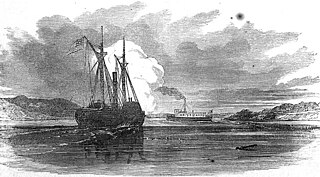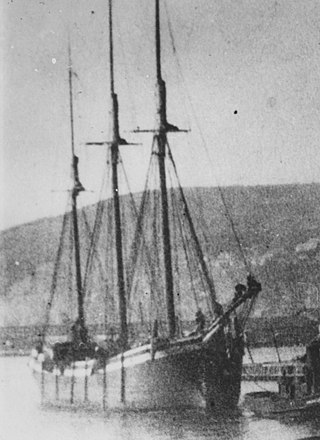
A tugboat or tug is a marine vessel that manoeuvres other vessels by pushing or pulling them, with direct contact or a tow line. These boats typically tug ships in circumstances where they cannot or should not move under their own power, such as in crowded harbors or narrow canals, or cannot move at all, such as barges, disabled ships, log rafts, or oil platforms. Some are ocean-going, and some are icebreakers or salvage tugs. Early models were powered by steam engines, which were later superseded by diesel engines. Many have deluge gun water jets, which help in firefighting, especially in harbours.

Northwest Seaport Maritime Heritage Center is a nonprofit organization in Seattle, Washington dedicated to the preservation and interpretation of Puget Sound and Northwest Coast maritime heritage, expressed through educational programs and experiences available to the public aboard its ships. The organization owns three large historic vessels docked at the Historic Ships' Wharf in Seattle's Lake Union Park; the tugboat Arthur Foss (1889), Lightship 83 Swiftsure (1904), and the halibut fishing schooner Tordenskjold (1911). These vessels are used as platforms for a variety of public programs, ranging from tours and festivals to restoration workshops and vocational training.

Ned Hanlan is a steam-powered tugboat that operated in Toronto Harbour in Toronto, Ontario, Canada. The tugboat entered service in 1932 and was retired in 1967. She was then put on display at Exhibition Place. She was moved in 2012 to Hanlan's Point on the Toronto Islands; she is named after champion rower Ned Hanlan.

Eppleton Hall is a paddlewheel tugboat built in England in 1914. The only remaining intact example of a Tyne-built paddle tug, and one of only two surviving British-built paddle tugs, she is preserved at the San Francisco Maritime National Historical Park in San Francisco, California.

The USCGC Acacia (WAGL-406/WLB-406) is an Iris-class 180-foot seagoing buoy tender operated by the United States Coast Guard. Acacia was a multi-purpose vessel, nominally a buoy tender, but with equipment and capabilities for ice breaking, search and rescue, fire fighting, logistics, oil spill response, and other tasks as well. She spent almost all of her 62-year Coast Guard career on the Great Lakes. After decommissioning she became a museum ship in Manistee, Michigan.

SS Milwaukee was a train ferry that served on Lake Michigan. It was launched in 1902 and sank with all hands off Milwaukee on October 22, 1929. Fifty-two men were lost with the vessel.

The Rouse Simmons was a three-masted schooner famous for having sunk in a violent storm on Lake Michigan in 1912. The ship was bound for Chicago with a cargo of Christmas trees when it foundered off Two Rivers, Wisconsin, killing all on board.

Luna is a historic tugboat normally berthed in Boston Harbor, Massachusetts. Luna was designed in 1930 by John G. Alden and built by M.M. Davis and Bethlehem Steel. She is listed on the National Register of Historic Places and is a U.S. National Historic Landmark. In 1985, the Luna was designated as a Boston Landmark by the Boston Landmarks Commission.

Samuel P. Ely is a shipwreck in Two Harbors, Minnesota listed on the National Register of Historic Places. It was a schooner that sailed the Great Lakes carrying iron ore, coal, and other bulk freight. It was built in 1869 and was a fairly typical example of the 200-foot schooner built in the 1870s, though she was reinforced for the demands of carrying iron ore.

The SS Vienna was built in 1873 during the era when steamers were built with sail rigging. She had a 19 year career marked with maritime incidents including sinking when she was just three years old. She sank for her final time in fair weather in Whitefish Bay in Lake Superior after she received a mortal blow when she was inexplicably rammed by the steamer Nipigon. Although there were no deaths when the Vienna sank for the last time, more than 100 years later her wreck claimed the lives of 4 scuba divers, the most of all the wrecks in the Whitefish Point Underwater Preserve that now protects her as part of an underwater museum. Her wreck was stripped of artifacts that resulted in the Michigan Department of Natural Resources seizing her artifacts in a raid on the Great Lakes Shipwreck Museum in 1992. Her artifacts are now on display in this museum as loan from the State of Michigan.

The SS Samuel Mather was the first of seven U.S. merchant ships to bear that name. The wooden Mather sank in 1891 after she was rammed by the steel freighter Brazil in heavy fog in Whitefish Bay 8 miles (13 km) from Point Iroquois, ending the Mather's 4-year career. Her intact wreck is a rare of example of wooden freighters that plied the Great Lakes and she is a popular scuba diving site. Although there was no loss of life when the Mather sank, her wreck claimed the lives of three scuba divers more than 100 years after she sank. Artifacts from her wreck were illegally removed in the 1980s by the Great Lakes Shipwreck Historical Society. The artifacts are now the property of the State of Michigan and are on display as a loan to the Great Lakes Shipwreck Museum. The wreck of the Mather is protected as part of an underwater museum in the Whitefish Point Underwater Preserve.

The Reykjavik Maritime Museum, formerly Víkin Maritime Museum, is a maritime museum located by the old harbour in the capital of Iceland, Reykjavík and run by Reykjavik City. The museum was established in 2005, and it is now one of five sites belonging to Reykjavik City Museum. There are seven exhibitions at the museum displaying Icelandic maritime history from the early settlements to the late 20th century. An important part of the museum is the Coast Guard and rescue vessel Óðinn. In 2008, the ship was transformed into a museum exhibit about the cod wars in the 1950s and 1970s. The ship also tells about its own history. The museum focuses on the history of fishing in Iceland but also displays temporary exhibitions related to the sea.

Urger, originally named H.J. Dornbos or Henry J. Dornbos, is a historic canal tugboat based at Waterford in Saratoga County, New York.

The Fishing Tug Katherine V., designated US 228069, is a Great Lakes fishing tug. Displayed at the Besser Museum of Northeast Michigan, in Alpena, Michigan, it is believed to be the last intact wooden fishing tug remaining. It was listed on the National Register of Historic Places in 2003.

The National Museum of the Great Lakes is a museum in the Toledo Maritime Center, a heritage location on the banks of the Maumee River on the east side of Toledo, Ohio. Operated by the Great Lakes Historical Society, it celebrates the natural and built heritage of the North American Great Lakes from a U.S. perspective. The museum is most noted as the docking location of a museum Lake freighter, the SS Col. James M. Schoonmaker.
Orin William Angwall or Orin W. Angwall was an American lake captain, commercial fisherman, and politician. He served in the Wisconsin legislature and was mayor of Marinette.

The Michigan Maritime Museum is a museum and research library located in South Haven in the U.S. state of Michigan. The museum is located next to the Dyckman Avenue bascule bridge on the Black River just in from Lake Michigan, the second-largest by volume of the five Great Lakes. The museum specializes in the maritime history of the state of Michigan and the lake of the same name.

The SS Lakeland was an early steel-hulled Great Lakes freighter that sank on December 3, 1924, into 205 feet (62 m) of water on Lake Michigan near Sturgeon Bay, Door County, Wisconsin, United States, after she sprang a leak. On July 7, 2015, the wreck of the Lakeland was added to the National Register of Historic Places.

Thomas Friant was a wooden-hulled ferry that served on the Great Lakes from her construction in 1884 to her sinking in 1924. In January 1924, while gillnetting out of Two Harbors, Minnesota in Lake Superior, she was holed by ice, and sank with no fatalities. In 2004 her wreck was discovered in over 300 feet (91 m) of water in pristine condition. The wreck of Thomas Friant was listed on the National Register of Historic Places in 2019.



















